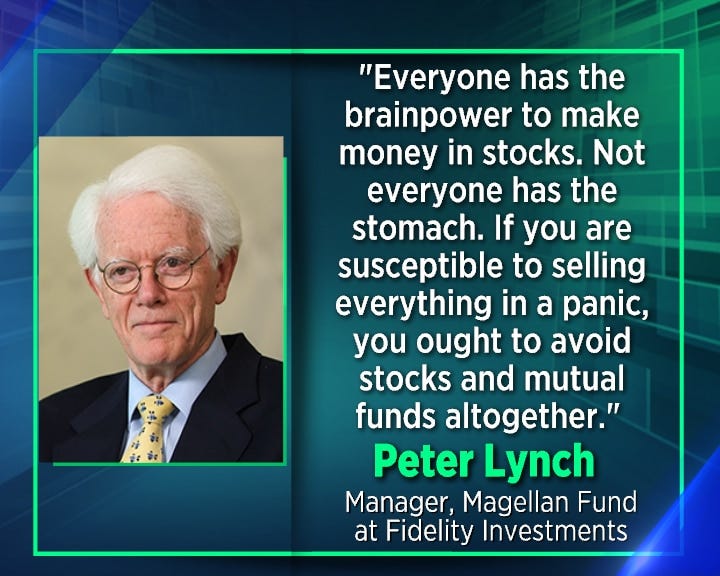- Learn To Earn Peter Lynch Pdf
- Learn To Earn Peter Lynch Book Review
- Learn To Earn Peter Lynch Pdf
- Learn To Earn Peter Lynch Free Download
- Learn To Earn Peter Lynch Pdf Free Download
Updated on February 19th, 2018
Peter Lynch is one of the most successful institutional investors of all time.
As the portfolio manager of Fidelity Investments’ Magellan Fund between 1977 and 1990, Lynch averaged a 29.2% rate of return. Further, Lynch beat 99.5% of all other mutual funds during the last five years of his tenure.
Learn to Earn: A Beginners Guide to the Basics of Investing and Business PDF book by Peter Lynch Read Online or Free Download in ePUB, PDF or MOBI eBooks. Published in 1995 the book become immediate popular and critical acclaim in economics, finance books.
A 29.2% rate of return is fantastic for a single year, let alone a 13-year period. For context, $1 invested in Lynch’s fund from the beginning would have turned into $28 when he retired 13 years later.
- Learn to Earn: A Beginner's Guide to the Basics of Investing and Business by John Rothchild and Peter Lynch (1996, Trade Paperback).
- In Learn to Earn, Lynch and Rothchild explain in a style accessible to anyone who is high-school age or older how to read a stock table in the daily newspaper, how to understand a company annual report, and why everyone should pay attention to the stock market. They explain not only how to invest, but also how to think like an investor.
- Written for beginner investors of all ages – with Burton Malkiel’s “A Random Walk Down Wall Street” – Peter Lynch’s “Learn to Earn” is one of the best introductions to investing ever published. If you are a teenager who doesn’t know anything about stocks, this is the place to start your journey to becoming a successful investor.
- Peter Lynch is an American investor and mutual fund manager, who currently spends a great deal of his time mentoring young analysts and giving away some of his money to charity. After graduating from Boston College and earning an MBA from the Wharton School, Lynch got a job with Fidelity Investments.
Aside from his fund management responsibilities, Peter Lynch was also passionate about educating people on investing.
His book One Up on Wall Street, where he outlines his belief that individual investors have the ability to beat the performance of professional money managers, has become a favorite among the investment community. Lynch has also authored two other books: Beating the Streetand Learn to Earn.
Despite his illustrious career as both a fund manager and an author, Peter Lynch’s investment philosophy was quite simple and can be summarized into four elements:
- Do your research
- Understand the importance of diversification
- Be patient
- Invest in what you know
Each will be discussed in detail below.

Table of Contents
You can skip to a particular section of this article by using the following table of contents:
Video Analysis
The following video provides a broad overview of Peter Lynch’s investment strategy:
Lesson #1: Do Your Research
Investing is a research-heavy endeavor. Peter Lynch recognized this and was a tireless worker during his tenure as the Magellan portfolio manager.
This persistence is well-defined in the quote below.
“The person that turns over the most rocks wins the game. And that’s always been my philosophy.” – Peter Lynch

By ‘turning over’ many rocks and investigating many stocks in different locations and industries, Lynch maximized the probability of finding companies with compelling investment prospects.
This strategy was evident in Lynch’s investing approach. His portfolio employed a wide degree of diversification (more on that later) at both the sector and geography levels. Lynch looked to all areas of the financial markets as a source of investment returns.
Many individual investors might think that this research-based approach is beyond them. It’s one thing to realize that research is an important component of a successful investment philosophy, but it’s another to have the chops to perform the analysis themselves.
This belief stems from the perception that investing is complicated. For evidence of the intricacies of investing, here are 101 financial metrics and ratios that can be implemented in stock analysis. Luckily, not all of those metrics are required to be successful in the markets.
Peter Lynch believed that no one was intellectually incapable of investing in the financial markets. One of Lynch’s most famous quotes describes his perspective on the minimal mathematical ability required to be successful in the markets.
“Everyone has the brainpower to follow the stock market. If you made it through fifth-grade math, you can do it.” – Peter Lynch
Further, Lynch didn’t just believe that anyone was smart enough to participate. He believed that individual investors can use their personal expertise to outperform institutional money managers.
Lynch recognized that there are many systemic disadvantages to managing large sums of money (including a smaller universe of investable stocks and trade execution concerns) and maintained that smaller investors have an advantage because of this.
Lynch taught that the end goal is to identify high-quality businesses with strong growth prospects. He also placed an emphasis on simple businesses that did not require much technical knowledge to lead.
“Go for a business that any idiot can run – because sooner or later, an idiot probably is going to run it.” – Peter Lynch

Learn To Earn Peter Lynch Pdf
At Sure Dividend, we recommend two databases of stocks to identify high-quality businesses: the Dividend Aristocrats and the Dividend Kings. Each is based on consecutive years of dividend increases, which shows that:
- The business is performing well (dividends cannot rise unless earnings do, at least not in the long run)
- The management is shareholder-friendly (or else they would not pay dividends)
The Dividend Aristocrats are a group of S&P 500 companies with 25+ years of consecutive dividend increases.
You can see the list of all 51 Dividend Aristocrats here.
Learn To Earn Peter Lynch Book Review
If the Dividend Aristocrats are not exclusive enough, then the Dividend Kings might be more suitable. The Dividend Kings are a group of companies with 50+ years of consecutive dividend increases.
You can see the list of all 19 Dividend Kings here.
Learn To Earn Peter Lynch Pdf

By applying a rigorous investment methodology (such as The 8 Rules of Dividend Investing) to groups of high-quality stocks like the Dividend Aristocrats, investors can capture some of the amazing success experience by Peter Lynch at Fidelity.
Lesson #2: Understand the Importance of Diversification
Peter Lynch ran a tremendously diversified stock portfolio. By the end of Lynch’s career, the Magellan fund was known to hold more than 1,000 individual stock positions at any given time.
Besides holding a high number of stocks, Lynch was also diversified by industry. This is not surprising given that he was an investment professional.
More uniquely, Lynch also diversified his portfolio based on the expected earnings growth of the underlying businesses. Namely:
- Fast Growers: Companies with expected earnings growth between 20% and 50% (Lynch never invested in companies with 50%+ expected growth rates because he rightly viewed this as unsustainable).
- Stalwarts: Large companies with multi-billion dollar sales and 10% to 20% expected earnings growth.
- Slow Growers: Companies that had expected earnings growth below 10% but paid a healthy dividend.
Lynch believed that stalwarts and slow growers provided stability in Magellan’s portfolio while fast growers were a source of alpha (outperformance over the benchmark).
What differentiates Lynch’s approach to diversification is that he does not buy stocks with less compelling investment prospects just to reduce the volatility of his portfolio.
This practice, which Lynch calls ‘diworseification’, is bound to reduce returns as investors take money that could be invested in their best idea and instead invest it in their nth best idea.
The fact that Lynch owned such a large number of stocks at any one time combined with his strict criterion of only investing in the best stocks is a testament to Lynch’s overall stock-picking abilities.
While individual investors likely cannot commit the time necessary to really know hundreds of stocks, much of the benefits of diversification can be achieved by owning ~20 stocks. This number will reduce risk and improve the chance of buying high-performing stocks.
Lesson #3: Be Patient
Like many other famous investors (Warren Buffett comes to mind), Peter Lynch began investing at a very young age. He famously paid for his graduate studies at the Wharton School of the University of Pennsylvania with the profits from an investment in Flying Tiger.
Lynch describes this experience below.
“So while I was in college I did a little study on the freight industry, the air freight industry. And I looked at this company called Flying Tiger. And I actually put a thousand dollars in it and I remember I thought this air cargo was going to be a thing of the future.” – Peter Lynch
The profits from Flying Tiger were 10x the price of Lynch’s original investment. He would later joke that he attended Wharton on a ‘Flying Tiger Graduate School Fellowship’.
Lynch’s early positive experience in the stock market undoubtedly helped him to develop the skills and interests that propelled his career from that point forward. An early entrance to the stock market also showed Lynch the remarkable powers of compound returns, helping him to invest for the long run over the rest of his career.
“The single greatest edge an investor can have is a long-term orientation.” – Seth Klarman
Investors who invest for the long run have many advantages over those who don’t.
Long-term investing allows for deferred capital gains taxes, lower brokerage commissions, and a better ability to withstand market downturns. All of these factors help to snowball your wealth over time.
Lynch’s long-term orientation helped to boost his performance, particularly during periods of economic recession. When stocks were tanking by ten or twenty percent, Lynch was not concerned because he knew the markets would be higher 5, 10, or 20 years down the road.
“You get recessions, you have stock market declines. If you don’t understand that’s going to happen, then you’re not ready, you won’t do well in the markets.” – Peter Lynch
The alternative to holding through recessions is selling during recessions. Investors sometimes sell stocks during recessions, hoping to either leave the markets completely or buyback their stock at lower prices.
While a sell and buyback strategy might work some of the time, it is a poor choice in general. Getting scared out of stocks tends to reduce investment returns on average.
“The real key to making money in stocks is not to get scared out of them.” – Peter Lynch
Related: The Long-Term Investing Guide to Compounding Wealth
Lynch was also famous for holding stocks whose prices had already risen a great deal since his initial investment. He compared selling his winners to purchase more of his poor performing stocks as similar to ‘pulling out the flowers and watering the weeds’. Thus, Lynch tended to hold stocks for long periods of time if the business’ prospects remained bright, even if the stock’s performance had been fantastic since his purchase.
The performance of individual investors is not measured on a quarterly basis like that of institutional investors. This allows individual investors to invest with a much longer time horizon, which is a key advantage over larger investment funds.
It was also a key contributor to Peter Lynch’s success and a strategy that any individual investor can use to improve investment results.
Lesson #4: Invest In What You Know
Perhaps the biggest lesson that investors can learn from Peter Lynch is to invest in ‘what you know’ – companies for which you have a thorough understanding.
“Never invest in any company before you’ve done the homework on the company’s earnings prospects, financial condition, competitive position, plans for expansion, and so forth.” – Peter Lynch
One of Lynch’s most famous qualities as an investor was his penchant for investing in businesses that he was intimately familiar with – not as a fund manager, but as a consumer. Lynch understood that consumers are the core of the economy, and his investment strategy reflected this.
There are numerous examples of stories where Lynch found fantastic investment opportunities in his day-to-day life. Two examples are:
- Lynch invested in undergarment manufacturer Hanes after his wife expressed satisfaction with their pantyhose. When a new competitor introduced a competing brand of pantyhose, Lynch bought samples of each and brought them to the Fidelity office for his colleagues to judge. When Hanes’ pantyhose was determined to be of higher quality (for a similar price), Lynch’s investment thesis was confirmed.
- Lynch invested in Flying Tiger (which paid for his graduate studies) because he viewed air freight as the transportation of the future. He profited tremendously when the Vietnam War began and the company began transporting troops and supplies to overseas.
While Lynch often got his best ideas from being a consumer himself, he did not blindly invest in these ideas without performing fundamental analysis first. Lynch emphasized that shareholders were business owners.

“Although it’s easy to forget sometimes, a share is not a lottery ticket…it’s part-ownership of a business.” – Peter Lynch
Learn To Earn Peter Lynch Free Download
A business owner would not execute an acquisition just because the products were popular. The acquisition would only be completed if a reasonable valuation could be agreed upon, and the business was fundamentally sound. Lynch applied this owner mentality to his investing.
As such, it is not surprising that many of his best-performing investments came from household names. Some of Lynch’s best investments are listed below.
- Ford (F)
- Phillip Morris (PM)
- General Electric (GE)
- Lowe’s (LOW)
Related: Blue Chip Stocks List: 3%+ Yield and 100+ Year Histories
Learn To Earn Peter Lynch Pdf Free Download
As investors, it’s important to recognize that we are also consumers. This means that we have deep insight into consumer trends – there is nothing stopping us from making observations about the behavior of customers at banks, shoppers at malls, or patrons at restaurants.
By watching what the people around us are buying (or perhaps more importantly, not buying), we can capture some of the investment magic that Peter Lynch demonstrated during his tenure at Fidelity.
Final Thoughts
One of the most helpful things for beginning investors is the ability to learn from the best in the business. Often, high-profile and successful investors are eager to share their perspectives with those willing to listen.
If you are interested in honing your investment skills by reading about other successful institutional investors, the following Sure Dividend articles may be of interest:



